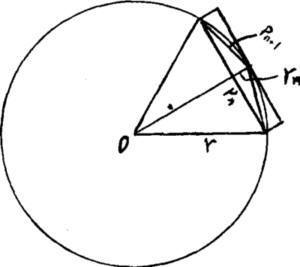Chapter 47 Chapter 11 Infinitesimal Partition Thoughts
For the circle area formula S=1/2Lr in "Nine Chapters of Arithmetic", before Liu Hui, it was based on the diameter of three weeks, and the circumference of the regular hexagon inscribed in the circle was taken as the circumference of the circle, and the area of the regular 12-gon was taken as the area of the circle , proved by the principle of complementarity in and out.Liu Hui pointed out that the circumference and diameter of a circle are "not the ratio of three diameters to one" ("Nine Chapters of Arithmetic · Fang Tian Zhang Note"), this proof is not strict.Liu Hui created a new method: he cut the circle from the regular hexagon inscribed in the circle, and obtained a regular 6·2-gon sequence.Let Sn be the area of 6·2 polygons, and pn be the length of each side, as shown in Figure 35.

Figure 35 Circumcision
Obviously, the larger n is, the smaller S-Sn is. It is said that "the smaller the cut, the less the loss." (same as above) and "the cut is cut again, so that it cannot be cut, and then it fits into the circle without losing anything." " (same as above) proves that L=lim6·2P. 6. There is a residual radius rn between each side of a 2-gon and the circumference.The side length multiplied by the residual radius is added to the area of the 6·2 polygon, which is greater than the area of the circle, that is, S<S<S+2(SS).
And when n is infinitely large, rn→0, then lim〔S+2(SS)〕=S
The so-called "if the cup is thin and fits with the circle, there will be no remaining diameter on the surface. If there is no remaining diameter on the surface, the power will not go out."This proves that the limit of the upper bound sequence and the lower bound sequence of the circle area is the circle area: S=limS.Then, Liu Hui said: "Using one side to multiply the radius, the goblet cuts it, and each time it doubles itself. Therefore, the circle power is obtained by multiplying the radius by half a circle." The infinite regular polygon is divided into infinitely many small isosceles triangles with the center of the circle as the vertex and each side of the polygon as the base. Since the length of each side multiplied by the radius is twice the area of the small triangle, the regular polygon that fits the circle The sum of the side lengths of is L, which proves that S=1/2Lr.Apparently, there are several rather rigorous limit processes involved here, and it is proved by dividing the area of the circle into infinitesimals, and then summing them up.This method is very close to the area element method before calculus.Mathematics historian Smith (DESmith, AD 1860-?) summarized the development of calculus into four stages: exhaustion method, infinitesimal method, flow number method and limit.Liu Hui has completed the first two stages, and has a clear limit process.

Figure 35 Circumcision
